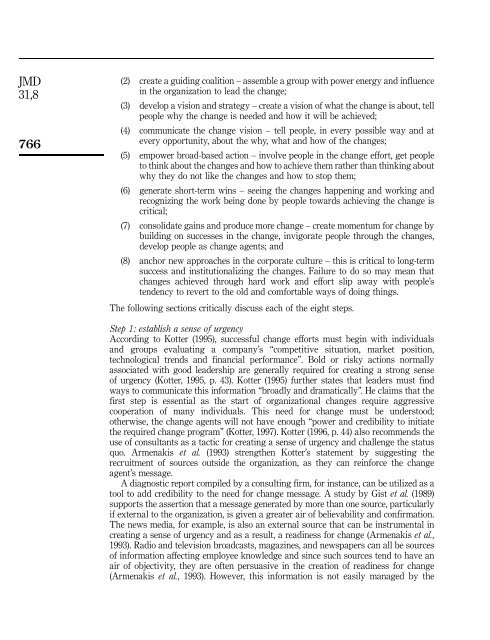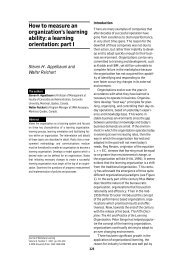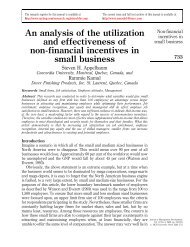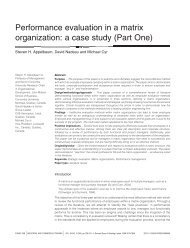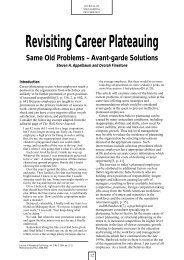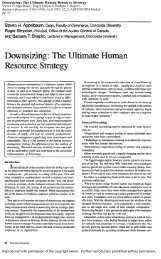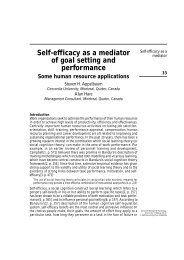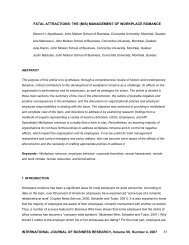Back to the future: revisiting Kotter's - Dr. Steven H. Appelbaum ...
Back to the future: revisiting Kotter's - Dr. Steven H. Appelbaum ...
Back to the future: revisiting Kotter's - Dr. Steven H. Appelbaum ...
Create successful ePaper yourself
Turn your PDF publications into a flip-book with our unique Google optimized e-Paper software.
JMD<br />
31,8<br />
766<br />
(2) create a guiding coalition – assemble a group with power energy and influence<br />
in <strong>the</strong> organization <strong>to</strong> lead <strong>the</strong> change;<br />
(3) develop a vision and strategy – create a vision of what <strong>the</strong> change is about, tell<br />
people why <strong>the</strong> change is needed and how it will be achieved;<br />
(4) communicate <strong>the</strong> change vision – tell people, in every possible way and at<br />
every opportunity, about <strong>the</strong> why, what and how of <strong>the</strong> changes;<br />
(5) empower broad-based action – involve people in <strong>the</strong> change effort, get people<br />
<strong>to</strong> think about <strong>the</strong> changes and how <strong>to</strong> achieve <strong>the</strong>m ra<strong>the</strong>r than thinking about<br />
why <strong>the</strong>y do not like <strong>the</strong> changes and how <strong>to</strong> s<strong>to</strong>p <strong>the</strong>m;<br />
(6) generate short-term wins – seeing <strong>the</strong> changes happening and working and<br />
recognizing <strong>the</strong> work being done by people <strong>to</strong>wards achieving <strong>the</strong> change is<br />
critical;<br />
(7) consolidate gains and produce more change – create momentum for change by<br />
building on successes in <strong>the</strong> change, invigorate people through <strong>the</strong> changes,<br />
develop people as change agents; and<br />
(8) anchor new approaches in <strong>the</strong> corporate culture – this is critical <strong>to</strong> long-term<br />
success and institutionalizing <strong>the</strong> changes. Failure <strong>to</strong> do so may mean that<br />
changes achieved through hard work and effort slip away with people’s<br />
tendency <strong>to</strong> revert <strong>to</strong> <strong>the</strong> old and comfortable ways of doing things.<br />
The following sections critically discuss each of <strong>the</strong> eight steps.<br />
Step 1: establish a sense of urgency<br />
According <strong>to</strong> Kotter (1995), successful change efforts must begin with individuals<br />
and groups evaluating a company’s “competitive situation, market position,<br />
technological trends and financial performance”. Bold or risky actions normally<br />
associated with good leadership are generally required for creating a strong sense<br />
of urgency (Kotter, 1995, p. 43). Kotter (1995) fur<strong>the</strong>r states that leaders must find<br />
ways <strong>to</strong> communicate this information “broadly and dramatically”. He claims that <strong>the</strong><br />
first step is essential as <strong>the</strong> start of organizational changes require aggressive<br />
cooperation of many individuals. This need for change must be unders<strong>to</strong>od;<br />
o<strong>the</strong>rwise, <strong>the</strong> change agents will not have enough “power and credibility <strong>to</strong> initiate<br />
<strong>the</strong> required change program” (Kotter, 1997). Kotter (1996, p. 44) also recommends <strong>the</strong><br />
use of consultants as a tactic for creating a sense of urgency and challenge <strong>the</strong> status<br />
quo. Armenakis et al. (1993) streng<strong>the</strong>n Kotter’s statement by suggesting <strong>the</strong><br />
recruitment of sources outside <strong>the</strong> organization, as <strong>the</strong>y can reinforce <strong>the</strong> change<br />
agent’s message.<br />
A diagnostic report compiled by a consulting firm, for instance, can be utilized as a<br />
<strong>to</strong>ol <strong>to</strong> add credibility <strong>to</strong> <strong>the</strong> need for change message. A study by Gist et al. (1989)<br />
supports <strong>the</strong> assertion that a message generated by more than one source, particularly<br />
if external <strong>to</strong> <strong>the</strong> organization, is given a greater air of believability and confirmation.<br />
The news media, for example, is also an external source that can be instrumental in<br />
creating a sense of urgency and as a result, a readiness for change (Armenakis et al.,<br />
1993). Radio and television broadcasts, magazines, and newspapers can all be sources<br />
of information affecting employee knowledge and since such sources tend <strong>to</strong> have an<br />
air of objectivity, <strong>the</strong>y are often persuasive in <strong>the</strong> creation of readiness for change<br />
(Armenakis et al., 1993). However, this information is not easily managed by <strong>the</strong>


